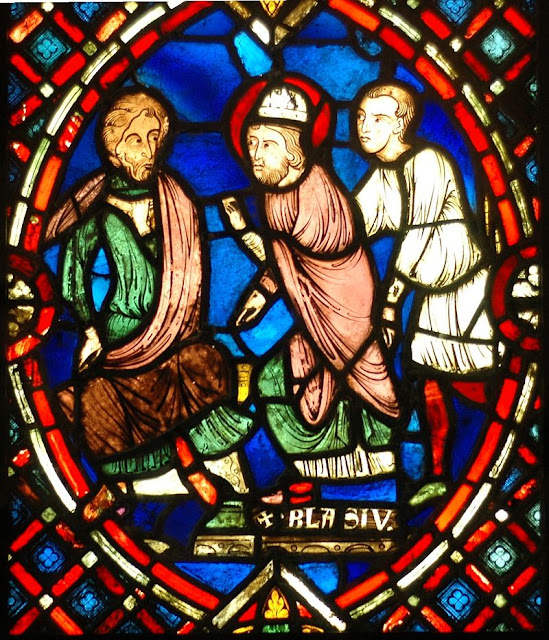 |
| St Blaize - 13th Century Church Window - Picardy, France |
Many of our Bancroft ancestors were ‘Woolcomber’, a difficult occupation at the best of times, usually men working from home in this cottage industry, but one which allowed them to earn a reasonable living until mechanisation took over in the mills of the early 19th century leaving them with no alternative but to move with the times, or seek an alternative way of making a living.
From the early medieval period through into the first half of the 19th century, England's worsted manufacturers held a great festival every seven years on February 3 to celebrate Bishop Blaise, the patron saint of woolcombers.
This obscure Armenian bishop was credited with having invented the wool comb and with its long and vicious spikes, was said to have been scourged and martyred in the 4th century.
 |
| Bradford Poster |
The event usually took place in leading worsted northern towns such as Bradford and Wakefield, but in 1777 Keighley held its own Bishop Blaise celebrations. This audacious move by the manufacturers of Keighley was met with some derision and lampooned in Leeds Intelligencer by an anonymous writer as follows:
An “audacious” move by Keighley manufacturers wasn’t well received by everyone,
"Such doings at Keighley sure never were seen!
Such clothing in scarlet and clothing in green!
All was conducted with such great decorum!
 |
| Drawing depicting St Blaize procession - 1814 |
Nevertheless, the Keighley celebration was a great success and fortunately a full description of it has survived written by a person who witnessed it. We are told that the procession began at 10 o'clock in the morning and continued throughout the district until five o'clock in the afternoon. It was led by six horsemen dressed in blue, with woollen wigs, tall grenadier caps and woollen sashes. Their horses were decorated with multi-coloured ribbons. They were followed by eight horsemen similarly dressed but in scarlet and with swords drawn. Then came two men on foot carrying a flag, perhaps in the form of a banner, which depicted Bishop Blaise and a woolcomber on one side and Jason with the ship that brought the Golden Fleece from Colchis on the other. Another two men followed carrying a flag with a golden fleece painted on both sides, which the writer of the doggerel inferred was the pub sign from the local public house, The Fleece Inn on Low Street, loaned by the innkeeper Jeremiah Booth.
Then followed a 'King and Queen', representing Jason and Medea, both mounted on horses, richly dressed and with crowns on their heads. Behind them came the bishop in his mitre and robes with a book in one hand and a wool comb in the other. He was followed by a mounted shepherd and shepherdess both dressed in green and carrying lambs. A group of wool-staplers came behind them with fleeces across their horses and they were followed by the tradesmen.
This second part of the procession was led by “the sons of Vulcan”, the comb makers fresh from their forges and carrying iron rods and the broaches, or steel pins, that were made from them. Next came the “son of Promethius, the charcoal burner…with his rakes and baskets tied to his horse's sides.” (Charcoal was used by woolcombers to heat their combs). A mounted band then followed playing popular music. Finally came the woolcombers themselves dressed in white linen with woollen wigs and grenadier caps bedecked with ribbons and escorted by eight horsemen dressed in scarlet and buff.
The account of the event concluded that “so great a concourse of people was never seen in this town at any one time. The procession was allowed (considered) by everyone that saw it, to excel everything of the kind that has ever appeared in Yorkshire.”
However, Keighley did not repeat the spectacle and left that to
other towns. Bradford continued the festival every seven years, the greatest of
which took place in 1825 with over 800 participants, of which 470 were
woolcombers [see the poster above, advertising the event]. Two more smaller-scale festivals were held in Bradford, one in
1832 and the other in 1839, before industrialisation finally rendered them
meaningless, with the invention of mechanical equipment such as the ‘Nobel
Comb’ which put the cottage industry in a swift decline, as wool processing moving into the numerous newly built mills springing up in all the northern towns.
 |
| The Noble Comb |
The city of Bradford, with its long history of being the wool capital of the county, still has a statue of St Blaize mounted outside its Wool Exchange building, where in times gone bye all the trading of wool in the area was carried out.
 |
| St Blaize at Bradford Wool Exchange |
I wrote an article some time ago about the life of my ancestors, many of whom were woolcombers, which can be read HERE.
[I am grateful to the Keighley News who provided some of this information]
No comments:
Post a Comment